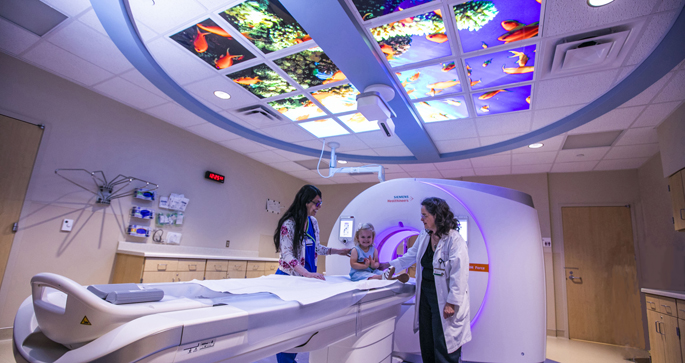
by Christina Echegaray
Traditional computed tomography (CT) imaging requires patients to stay still or hold their breath for periods of time as the scan is performed so a clear image is obtained the first time.
For young children and/or infants, staying still or not crying can be a challenge, and getting the best image the first try is important to reduce unnecessary, repeated radiation exposure. If the patient moves or cries during a scan, the images become severely limited and might need to be repeated.
New CT technology at Monroe Carell Jr. Children’s Hospital at Vanderbilt is changing the medical imaging landscape for young children and adolescents. The hospital’s new machine, called the Somatom Force, is considered the Cadillac of CT imaging technology with capabilities to scan so fast as to freeze motion during scans, and most importantly, it can use ultra-low radiation exposure for pediatric patients — all while producing the detailed images needed for treating and caring for children.
A CT machine is a computerized X-ray machine that takes cross-sectional images to create detailed pictures of organs, bones, soft tissues and blood vessels.
“CT saves lives and avoids much more invasive procedures such as exploratory surgery in many cases, but should only be done when it is necessary, so the principle of justification is really important. You would want to consider other modalities that don’t have radiation, such as ultrasound. But if CT is what the patient needs, this is the place to do it,” said Marta Schulman, MD, chief of Pediatric Radiology, medical director of Diagnostic Imaging and professor of Radiology and Pediatrics.
“We have dedicated pediatric technologists and pediatric radiologists who are very involved and follow strict protocols for young children and adolescents. We make sure the examination is optimized to the indication so that we do it at the lowest possible dose.”
The new CT machine scan is so quick that it takes longer to get the patient onto the table than to obtain the scan. The machine can scan 2.4 feet per second — about the length of a toddler — so that many studies on children can be done at sub-second speed. Its speed and ability to freeze motion also means fewer instances where children need to be sedated.
Most CT scans on children are done with intravenous contrast material, but occasionally a “pre-contrast” scan is needed. This scanner is able to perform “dual energy scanning,” which means that a “virtual pre-contrast” scan can be generated by the computer, so the patient only needs to be scanned once rather than twice, thus halving the radiation dose required with a conventional scanner in such cases.
The colors inside the doughnut-shaped tube rotate between calming colors of purple, red, blue and yellow. On the ceiling of the room above the machine, the children can look up at a coral reef full of goldfish that illuminate when the rooms lights are turned down.
Susan Brewer was impressed when her son, William, 6, went through the new CT machine, immediately noticing a difference compared to the old CT.
William, who has Treacher Collins Syndrome (the syndrome featured in the movie “Wonder”), is followed by multiple specialists at Children’s Hospital. He has received several CT scans to monitor and assess treatment options related to his jaw as well as bone growth in other areas of his body.
“This was his eighth CT — his first with the new machine — and it was by far the fastest and the quietest. The benefits of a faster machine, especially when dealing with children, are crucial,” she said.
“We have had to have CTs done in trauma situations and for routine things, and every time, if the image was not captured correctly the first time it became harder to do subsequent times. This time (with the new CT), he was up on the table and in and out of the machine in the time that it would take them to get the previous machine started. It was a much smoother ride for him in and out and significantly quieter. The radiology staff, as always, were amazing. We love them,” Brewer added.












